Industry News, trenchless people
 CDM Smith environmental engineer Ajay Shrivastav, P.E., ENV SP, is the winner of Trenchless Technology’s World Trenchless Day (WTD) Sweepstakes.
CDM Smith environmental engineer Ajay Shrivastav, P.E., ENV SP, is the winner of Trenchless Technology’s World Trenchless Day (WTD) Sweepstakes.
The WTD Sweepstakes was hosted by Trenchless Technology and was generously sponsored by Akkerman, Applied Felts, Michels Corp., Maxliner, NASTT and Vortex Companies. The Sweepstakes generated more than 400 entries throughout the year, with the drawing held on World Trenchless Day.
Shrivastav’s prize package includes: one free conference registration to the NASTT 2020 No-Dig Show, April 5-9; a ticket to attend the annual No-Dig Show Gala Awards Banquet Dinner on April 7; standard room accommodations at the host hotel for up to four nights and up to $500 for airfare to Denver.
 Congratulations Ajay and we’ll see you in Denver!
Congratulations Ajay and we’ll see you in Denver!
Want to join him? Register today and save before early discounted registration ends.
Industry News, trenchless people, trenchless products
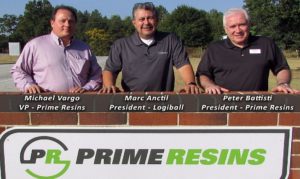 Conyers, GA – November 15, 2019 – USL Group announced today that it has acquired Logiball Inc., a leading manufacturer of trenchless pipe rehabilitation equipment headquartered in Quebec, Canada. Terms of the transaction were not disclosed.
Conyers, GA – November 15, 2019 – USL Group announced today that it has acquired Logiball Inc., a leading manufacturer of trenchless pipe rehabilitation equipment headquartered in Quebec, Canada. Terms of the transaction were not disclosed.
Founded in the early 1980s, Logiball holds a leading position in the manufacturing and supply of inflatable pipe plugs and test-and-seal injection packers for the maintenance and trenchless rehabilitation of collection systems and gravity pipes compromised by groundwater intrusion – a sizable segment of the general infrastructure sector known as the Inflow and Infiltration (I&I) market.
Logiball’s main product range is test-and-seal injection packers, which are used to confine and apply grouts for the repair of points of water ingress and egress from pipes, such as leaking joints or cracks. Logiball is the primary producer of these specialized products, which has allowed the company to forge a strong position in the niche of the I&I market.
“This acquisition provides channel synergies for both Logiball and our Prime Resins business, which makes chemical grouts. It will enable both companies to expand their reach in the growing I&I market space by leveraging their joint reputations and product offerings” said John Taylor, Director at USL Group. “Prime Resins has actively pursued growth in this market space, and the clear synergies with Logiball will lead to product improvement and expansion of use that will benefit the Trenchless Rehabilitation industry as a whole”.
About USL
Founded in 1981, USL Group of companies are market leaders in the provision of specialist civil engineering and construction solutions. For nearly four decades, USL Group has been at the forefront of cutting-edge resin and cementitious technology, combining high performing innovative products, first class operations, expert technical support and unrivalled customer service. Specializing in expansion joints, structural and liquid waterproofing, construction chemicals, concrete repair systems, injection resins and specialist safety & anti-slip products, USL boasts a comprehensive portfolio of products and a highly developed global network. For more information about USL, visit www.uslgroup.com.
Industry News, trenchless people, trenchless products
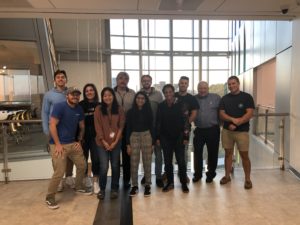 Recently two of NASTT’s very dedicated volunteers, Dennis Walsh and George Ragula, both of PSE&G, met with our Rutgers Student Chapter to give a presentation.
Recently two of NASTT’s very dedicated volunteers, Dennis Walsh and George Ragula, both of PSE&G, met with our Rutgers Student Chapter to give a presentation.
The presentation covered a project that is the new world record diameter 42” CIPL renewal that included an extremely complicated piping geometry involving seven bends in a u-tube configuration crossing a major parkway with a significant change in vertical elevation.
The project presentation was fascinating and the students were thrilled to have two industry experts on hand to answer questions and provide insight. Future presentations and job site visits are in the works.
Pictured are volunteers and student members:
Left to right, front row: Max Ritner, Sharon Xiao, Riya Maniar and Kendi Bailey.
Left to right, back row: Amil Muminovic, Demetra Tampasis, George Ragula, Ian Walczak, Anthony Genchi, Dennis Walsh and Troy Dittenhofer.
Industry News, trenchless people
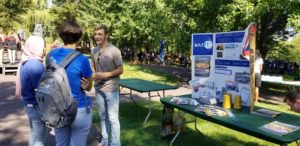 Recently the NASTT Student Chapter at UMASS Lowell participated in the school’s annual campus club recruiting event. They had a table at the event outlining what the student chapter does and why trenchless matters. These students are passionate about growing interest in the trenchless industry!
Recently the NASTT Student Chapter at UMASS Lowell participated in the school’s annual campus club recruiting event. They had a table at the event outlining what the student chapter does and why trenchless matters. These students are passionate about growing interest in the trenchless industry!
NASTT volunteer instructor and “Trenchless Guru” (yep, that’s his X handle!), Dennis Doherty, is very involved with the students at UMASS Lowell and volunteers his time to mentor these future trenchless champions. Dennis is the National Practice Leader of Trenchless Technologies at Haley & Aldrich. Dennis said, “Get involved with our students. They are our future”. We couldn’t agree more!
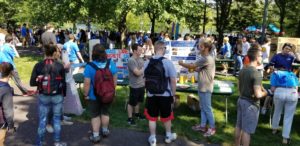
Industry News, trenchless people, trenchless projects
When contractors provide estimates that include a sewer bypass, accuracy is essential—each project is unique, and accounting for these nuances is critical to maintaining margins. Failure to plan on the front end may lead to an influx of change orders and a big hit to the bottom line. Damages could go further than money alone: An estimating mistake might lead to a sanitary sewer overflow (SSO). Following an SSO, you can expect large sums for cleanup and DEQ penalties, along with negative PR and a ripple effect that could impact future projects.
Before submitting a bid, it’s critical to cover all the bases and avert potential problems on the job. The following lessons learned can help contractors avoid estimating mistakes, win bids, and complete projects at a profit—and without visits from the DEQ.
Lesson 1: Take a bottom-up approach to estimating.
Often estimators have little choice but to use unit costs, like cost per foot of pipe, for an estimate. But that doesn’t eliminate the need to check the latest prices. Inserting the cost from the last project without checking it seldom produces a safe number. Even if a job appears to be the same size and complexity as a previous project, treat every job individually and get a current price for every item.
Lesson 2: Always visit the project site with a knowledgeable individual.
Unforeseen site conditions are the largest contributor to project change orders and increased costs. Plans and drawings alone do not provide the information needed to route pipe, situate pumps, and manage flow for a sewer bypass. Avoiding this mistake is easy: Always visit the site with the engineer or a representative from the municipality—whoever has the most in-depth knowledge of the project. The sewer bypass subcontractor should also attend to explain the capabilities, as well as the limitations, of the pumping system. Consulting with the entire team will help ensure a solid quote for that portion of the contract.
Lesson 3: Insist on backup detail for subcontractor quotes.
Contracting firms often use subcontractors to design a sewer bypass for a larger project. Even if the subcontractor has complete confidence in the system as designed, never take their word that it will handle the sewer bypass flow for the cost they plan to charge. Instead, request the engineering calculations and system drawings, and then ask the design engineer to review them. Based on the information the subcontractor provides, the scope of equipment, system layout, and performance should be clear.
Lesson 4: Do due diligence on labor costs.
Labor costs often comprise the largest portion of a sewer bypass budget. Costs for prevailing wage and certified payroll add up quickly. Different project conditions can impact labor costs significantly, even for the same task. For example, a team working on a city street with heavy traffic may install less bypass piping each day than one working in an open field. Therefore, it’s critical to examine labor costs in detail over the project timeline, including hours and types of labor for each task. Then, make sure your bypass subcontractor offers a firm commitment on the cost.
Lesson 5: Factor in risk and the potential for lost revenue when accepting a low bid.
Although selecting the subcontractor with the lowest bid can be tempting, ultimately the project may cost more. Never assume a subcontractor will take responsibility for problems that result from lack of experience or expertise. Instead, consider all the worst-case scenarios that could occur, such as a sanitary sewer overflow. Ensure the subcontractor can manage each and every problem that may arise. Double check contract limitations and exclusions, the safety plan, and the spill and emergency response plan. In addition to liability considerations, it’s critical to review a bypass subcontractor’s bid to ensure it is complete. Have they included enough in labor costs to complete the project? Are fuel costs included, or even tax? Low bids may leave out these important components which can result in lost profits.
Lesson 6: Review the engineering submittal with the subcontractor.
To ensure all the estimate information is correct, always review the engineering submittal against the specifications with the subcontractor to make sure it matches the information in the request for quote. As a best practice, the engineering submittal should include not only the information required within the specifications, but also all the pertinent details about the temporary pumping system. It should be clear and concise so anyone who reads it will fully understand how the system is designed, set up, and operated. It should also have all the supporting documentation such as fluid calculations, drawings, and specification sheets on the equipment being used.
Checking the engineering submittal against the specifications will help to reduce or eliminate the engineer sending the submittal back for changes. Until the submittal is approved, the job cannot go forward, so in order to keep the project on track, it’s important to cross-check the documents before sending to the engineer.
Lesson 7: Assume the cost quoted can never be modified.
Do not count on subcontractors to take responsibility for problems and resolve them in a timely manner. The contractor is ultimately on the line and will be held to the amount put in every box on every bid. To be competitive, a firm’s margins must remain as low as possible while still providing a profit. If a quote does not include every item down to the last fitting and bolt, the margin and profit will suffer. The bypass subcontractor and firm should work together to determine the right costs to put into the bid tabulation sheet. Also, to avoid being buried in unanticipated invoices, be certain to incorporate a billing schedule with the bypass subcontractor that indicates when invoices will be received and what they are for.
Abiding by these seven lessons learned should avert many potential problems that occur in sewer bypass and ensure a winning bid that leads to a profitable and successful project.
For more information, visit www.sunbeltrentals.com or call 800-736-2504.
Industry News, The No-Dig Show, trenchless people
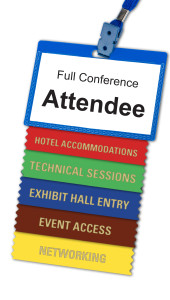
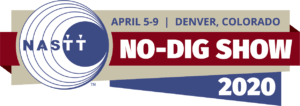 The North American Society for Trenchless Technology (NASTT) — the leading association serving and promoting the North American trenchless industry — is pleased to announce municipal and public utility scholarship opportunities to attend the NASTT 20202 No-Dig Show, April 5-9 in Denver, Colorado.
The North American Society for Trenchless Technology (NASTT) — the leading association serving and promoting the North American trenchless industry — is pleased to announce municipal and public utility scholarship opportunities to attend the NASTT 20202 No-Dig Show, April 5-9 in Denver, Colorado.
In 2013, NASTT established the No-Dig Show Municipal & Public Utility Scholarship Award Program to provide education and training for employees of North American municipalities, government agencies and utility owners who have limitedor no training funds due to economic challenges. In past years, over 100 applicants were awarded the scholarship annually.
“The NASTT Municipal & Public Utility Scholarship offers public agencies the opportunity in which to participate and experience the world of trenchless. Since its inception in 2013, scholarships have been awarded to more than 850 applicants, and the success of the program continues to increase every year.” said Joe Lane, 2020 No-Dig Show Program Chair and V.P. of International Operations for Insituform. “With an entire show dedicated to trenchless technology, this scholarship is a tremendous opportunity for municipal & public utility employees to attend at little or no cost.”
Selected scholarship winners will be awarded Full Conference and Exhibition registration to the NASTT 2020 No-Dig Show. Also available are one day conference registrations which include full access to all exhibits and technical paper sessions. Selected applicants will also be eligible to receive complimentary overnight accommodations for three nights at the host hotel. The scholarship applications are reviewed by a committee of NASTT volunteers and awarded based upon the supplied responses.
To apply for the scholarship, complete the application online at
nastt.org/no-dig-show/municipal-scholarships on or before November 1, 2019. Applicants are not required to be NASTT members.
NASTT’s Municipal & Public Utility Scholarships program is sponsored by Benjamin Media, Inc, award-winning publisher of the leading underground construction magazine, Trenchless Technology.
For more information about NASTT’s No-Dig Show visit www.nodigshow.com, email conferences@benjaminmedia.com or call 330-467-7588.
 CDM Smith environmental engineer Ajay Shrivastav, P.E., ENV SP, is the winner of Trenchless Technology’s World Trenchless Day (WTD) Sweepstakes.
CDM Smith environmental engineer Ajay Shrivastav, P.E., ENV SP, is the winner of Trenchless Technology’s World Trenchless Day (WTD) Sweepstakes. Congratulations Ajay and we’ll see you in Denver!
Congratulations Ajay and we’ll see you in Denver!





 The North American Society for Trenchless Technology (NASTT) — the leading association serving and promoting the North American trenchless industry — is pleased to announce municipal and public utility scholarship opportunities to attend the NASTT 20202 No-Dig Show, April 5-9 in Denver, Colorado.
The North American Society for Trenchless Technology (NASTT) — the leading association serving and promoting the North American trenchless industry — is pleased to announce municipal and public utility scholarship opportunities to attend the NASTT 20202 No-Dig Show, April 5-9 in Denver, Colorado.